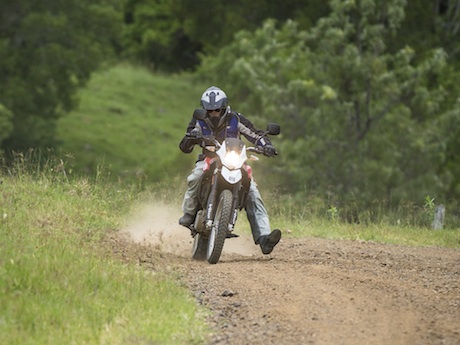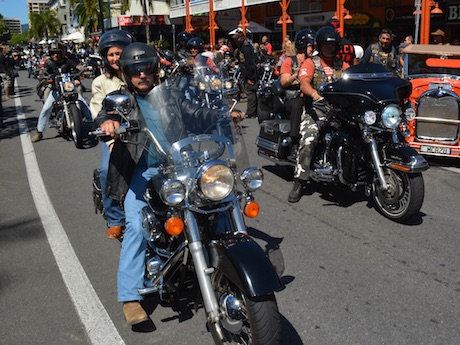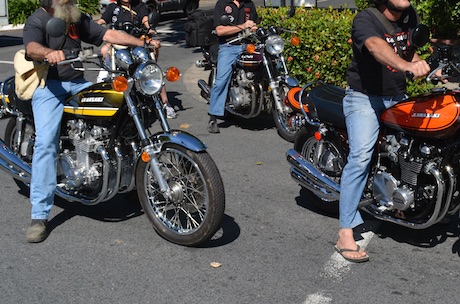Riders should keep their feet on the footpegs whenever their bike is moving to retain control, balance and to use the rear brake for slow manoeuvres.
Until recently, riders were banned from taking their feet off the footpegs in a badly written piece of legislation designed to stop people from hooning and performing stunts on motorcycles.
It basically meant you couldn’t stretch your legs or even put your feet down when you came to a traffic light or to park your bike.
The ridiculous piece of legislation has now been amended.
However, while it is fine to occasionally stretch your legs and use your feet to stop the bike from falling over when stopped and parking, you should keep your feet on the pegs all the time while your bike is moving. (Obviously, this does not apply to off-road riding where you often put a foot down to support the bike.)

Footpegs are important
That means not waddling along at slow speeds with both feet on the ground or coasting up to the lights with your feet down. And when you stop, you should only put your left foot on the ground and leave your right foot on the brake.
Why? Because the footpegs are nearly as important as the handlebars in controlling the bike.
Many people drop their bikes because as they near a stop or are travelling at slow speeds, they have only the front brake to stop them.
At that speed, a front brake can make the front wheel tuck in and the bike pitch to one side.
If you’ve ever watched bike cops leading a parade at super-slow speeds, you will notice they have their right hand off the brake and their right foot trailing the brake as it steadies the bike.
Using the rear brake only can also be handy when doing u-turns and tight roundabouts.
Probably the biggest culprits of having both feet off the pegs at slow speeds or coming to a stop are cruiser riders who feel they lose their balance because their footpegs are further forward.
Practise makes perfect
It does take a bit of practice, but you will find you have more control if you leave their you foot on the brake. Once stopped, a big bike may need you to then place two feet on the ground, especially if there is a lot of luggage and a passenger also on board.
Great advocates of using the rear brake and keeping your feet on the footpegs are legendary motorcycle tour operators Mike and Denise Ferris of World on Wheels Motorcycle Adventure Tours.
“In over 70 motorcycle tours that Ferris Wheels has run so far we have never yet run a single tour where no-one drops a bike,” he says.
“There is always an ‘incident’ or two, usually just a simple slow-speed drop without injury, but here’s the thing: 95% of these mishaps are operator error and are the result of incorrect, ineffectual braking. They could have, and should have, been avoided.”
He refers to the low-speed manoeuvre where riders take both feet off the pegs for the final 20m of a stop with their boots hovering above the road as the “Landing Pelican”.
“Whenever we ask why they do this, the answer is usually along the lines of: ‘I need to be ready for when the bike becomes unstable’,” he says.
“Our reply to this is, the bike is far more likely to become unstable when you take your feet off the footpegs. Stop the bike first, put your foot on the ground second.”
Balance
Taking your feet off the pegs affects its balance and centre of gravity. After all, your feet and legs are more than one third of your body weight. If you weigh 90kg, that represents more than a 30kg shift in weight balance on the bike.
When you come to a stop, you should only put down your left foot so you can keep your right foot on the brake in case you are shunted from the rear as it will prevent you from being thrown forward.
Holding the front brake won’t help because if you are hit from the rear, your hand will instinctively let go of the lever, but your foot will be pushed harder on the foot brake.
Many riders put the bike into neutral when stopped as they believe leaving the bike in gear with the clutch in will damage the clutch.
However, a motorcycle clutch is different to a car clutch, It is designed to slip at low speed without damage.




